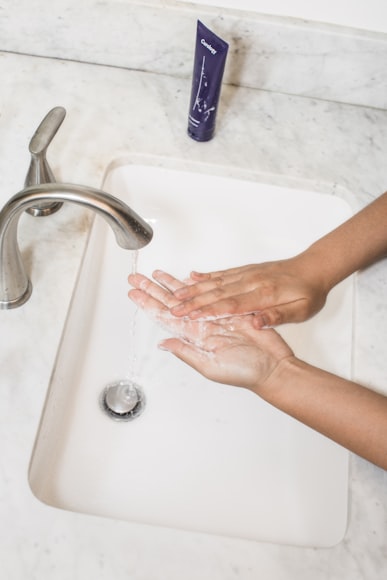Epsom Salt Baths for Itchy Skin in Dogs: A Solution to the Itch

Itchy skin is a common problem in dogs, caused by various factors such as allergies, skin infections, and parasites. While there are numerous treatments available, Epsom salt baths have emerged as a natural and effective solution to provide relief and soothe your dog’s irritated skin.
What is Epsom Salt?
Epsom salt, also known as magnesium sulfate, is a natural compound composed of magnesium, sulfate, and oxygen. It has been used for centuries as a home remedy for various human and animal ailments, including skin conditions.
How Epsom Salt Baths Help Itchy Skin in Dogs?
Epsom salt baths possess several properties that make them beneficial for treating itchy skin in dogs:
- Anti-inflammatory: Magnesium has anti-inflammatory properties, which help reduce inflammation and swelling in the skin. This can alleviate itching and discomfort.
- Antibacterial and antifungal: Sulfate has antibacterial and antifungal properties, making it effective in treating skin infections that may be contributing to itching.
- Soothes and hydrates: Epsom salt baths provide a soothing and hydrating effect on the skin, helping to reduce dryness and irritation.
How to Use Epsom Salt Baths for Itchy Skin in Dogs
To prepare an Epsom salt bath for your dog, follow these steps:
- Prepare the Bath: Fill a bathtub or large basin with warm water (not too hot). Add 1/2 cup of Epsom salt per gallon of water.
- Soak Your Dog: Place your dog in the bath and allow them to soak for 10-15 minutes. Use a cup or sponge to gently pour the Epsom salt water over their skin.
- Rinse Thoroughly: After the soak, rinse your dog thoroughly with clean water to remove any residual Epsom salt.
- Pat Dry: Use a towel to gently pat your dog dry. Avoid rubbing, as this can irritate their skin.
Frequency of Baths
The frequency of Epsom salt baths will depend on the severity of your dog’s skin condition. For mild itching, one or two baths per week should suffice. If the itching is more severe, you may need to bathe your dog more frequently, such as every other day.
Safety Considerations
Epsom salt baths are generally safe for dogs, but there are a few precautions to keep in mind:
- Do not use Epsom salt baths on dogs with open wounds or skin infections.
- If your dog swallows Epsom salt water, it can lead to digestive upset.
- Avoid using Epsom salt baths too frequently, as this can cause dehydration.
Conclusion
Epsom salt baths can be a safe and effective way to relieve itchy skin in dogs. By providing anti-inflammatory, antibacterial, and soothing properties, Epsom salt helps reduce inflammation, heal skin infections, and moisturize the skin, alleviating discomfort and promoting your dog’s well-being. However, it’s important to follow the safety guidelines and consult with your veterinarian if your dog has a severe skin condition or underlying medical issues.
Understanding Itchy Skin in Dogs

Itchy skin, medically known as pruritus, is a common problem that affects dogs of all ages and breeds. It can cause significant discomfort and lead to a variety of skin problems if left untreated. Understanding the causes and symptoms of itchy skin is crucial for providing your furry friend with proper care and relief.
Common Causes of Itchy Skin
- Allergies: Dogs can develop allergies to various substances, including food ingredients, environmental allergens (e.g., pollen, dust mites), and insect bites. Allergies cause the release of histamine, which triggers inflammation and itching.
- Parasites: Fleas, ticks, and mites can burrow into a dog’s skin, causing intense itching and irritation.
- Infections: Bacterial and fungal infections can also cause itchy skin. These infections can occur on the skin’s surface or deep within it.
- Contact dermatitis: This condition occurs when a dog’s skin comes into contact with irritants such as chemicals, plants, or fabrics.
- Skin disorders: Certain skin diseases, such as eczema and seborrhea, can cause severe itching and inflammation.
Symptoms of Itchy Skin
- Scratching: The most common symptom of itchy skin is excessive scratching. Dogs may scratch at their ears, paws, flanks, or any area of their body where they experience discomfort.
- Biting: Some dogs may bite at their skin to relieve the itching. This can lead to hair loss, scabs, and skin damage.
- Licking: Licking can be a sign of itchy skin, especially on the paws or legs. Excessive licking can lead to moisture accumulation and secondary infections.
- Rubbing: Dogs may rub their body against furniture or objects to alleviate the itching.
- Swelling: Inflamed skin can appear red, swollen, and painful.
- Hair loss: Itchy skin can lead to hair loss due to scratching and biting.
- Skin lesions: Scratching and biting can cause open sores, scabs, and crusting on the skin.
Diagnosis and Treatment
If you notice any of the symptoms of itchy skin in your dog, it’s important to consult with your veterinarian. They will perform a thorough physical examination, collect a medical history, and may conduct additional tests to determine the underlying cause.
Treatment for itchy skin will depend on the specific diagnosis. In general, it may involve:
- Antihistamines: These medications block the effects of histamine, providing relief from itching.
- Anti-inflammatory medications: These drugs reduce inflammation and discomfort.
- Antibiotics or antifungals: These medications treat bacterial or fungal infections causing itching.
- Parasiticides: These treatments kill fleas, ticks, and mites and prevent future infestations.
- Allergy management: If allergies are the cause, your veterinarian may recommend identifying and avoiding allergens or administering allergy shots.
- Skin soothing products: Shampoos, creams, and sprays containing anti-itching and moisturizing ingredients can provide temporary relief.
Prevention and Care
While not all causes of itchy skin can be prevented, there are some steps you can take to reduce the risk:
- Regularly bathe your dog with a mild, hypoallergenic shampoo.
- Brush your dog’s fur to remove loose hair and dirt.
- Inspect your dog for any signs of fleas, ticks, or mites.
- Use flea and tick prevention products as recommended by your veterinarian.
- Keep your dog out of contact with known allergens.
- Provide a clean and comfortable environment for your dog.
Itchy skin can be highly distressing for dogs. By understanding the common causes and symptoms, you can work with your veterinarian to identify the underlying issue and provide effective treatment. Early intervention can prevent the development of more serious skin problems and ensure that your beloved companion enjoys a comfortable and healthy life.
Benefits of Epsom Salt Baths

Epsom salt, a natural mineral compound composed of magnesium sulfate, has been used for centuries for its therapeutic properties. When dissolved in warm water, Epsom salt releases magnesium and sulfate ions that are easily absorbed through the skin, providing numerous health benefits. Let’s explore the remarkable benefits of Epsom salt baths and how they can enhance our well-being:
1. Soothes Inflammation and Reduces Itching:
Inflammation is a common culprit behind pain, swelling, and discomfort. Magnesium plays a crucial role in reducing inflammation throughout the body. When you soak in an Epsom salt bath, the magnesium ions penetrate the skin and interact with cells, inhibiting the release of inflammatory chemicals. This soothing effect helps alleviate pain and reduce swelling in areas such as sore muscles, sprains, and bruises. Additionally, Epsom salt baths can provide relief from itchy skin conditions like eczema and psoriasis by calming irritated nerve endings.
2. Promotes Relaxation and Calm:
Epsom salt baths are renowned for their calming and stress-relieving effects. Magnesium has been shown to have a relaxing effect on the nervous system. When absorbed through the skin, it helps reduce muscle tension, promotes relaxation, and improves mood. A warm Epsom salt bath before bedtime can create a relaxing environment, making it easier to fall asleep and enjoy restful sleep.
3. May Help Kill Bacteria and Fungi:
Epsom salt baths may also possess antimicrobial properties. Sulfate ions have been demonstrated to have antifungal and antibacterial effects against certain microorganisms. Soaking in an Epsom salt bath can help kill bacteria and fungi that may be present on the skin, promoting wound healing and preventing infections.
Additional Benefits:
• Detoxification: Epsom salt baths are believed to aid in the elimination of toxins from the body. Magnesium sulfate helps draw out impurities and toxins through the skin, contributing to overall detoxification.
• Improved Circulation: The warm water of an Epsom salt bath can promote blood flow and circulation throughout the body. This increased circulation can help alleviate cold hands and feet, improve skin health, and reduce the risk of blood clots.
• Exfoliation: Epsom salt crystals can act as a gentle exfoliant when dissolved in water. They help remove dead skin cells, promoting smoother and brighter skin.
How to Use Epsom Salt Baths:
To experience the benefits of Epsom salt baths, dissolve 1-2 cups of Epsom salt in warm bathwater. Soak for at least 20 minutes, allowing the magnesium and sulfate ions to be absorbed into the skin. Repeat the bath as needed for optimal results.
Safety Considerations:
While Epsom salt baths are generally safe for most people, there are a few safety considerations to keep in mind:
• Pregnancy: Pregnant women should consult their doctor before using Epsom salt baths.
• Kidney Disease: Individuals with kidney disease should avoid Epsom salt baths as they may increase magnesium levels.
• Open Wounds: Epsom salt should not be used on open wounds or skin irritations.
Conclusion:
Epsom salt baths offer a myriad of therapeutic benefits, including reducing inflammation, promoting relaxation, killing bacteria and fungi, and more. By incorporating Epsom salt baths into your routine, you can enhance your well-being, relieve stress, and experience the soothing and rejuvenating effects of this natural remedy. Whether you’re looking to alleviate discomfort, unwind after a long day, or simply pamper yourself, an Epsom salt bath is a simple and effective way to improve your physical and mental health.
How to Prepare an Epsom Salt Bath

Indulge in the therapeutic benefits of an Epsom salt bath, a rejuvenating ritual that has been passed down for generations. This simple yet effective treatment offers a myriad of health and relaxation advantages, from alleviating muscle soreness to reducing stress. Here’s a comprehensive guide to help you prepare and enjoy the perfect Epsom salt bath:
Choosing the Right Epsom Salt
Not all Epsom salts are created equal. Look for pure Epsom salt, also known as magnesium sulfate. Avoid scented or colored varieties, as they may contain additives that can irritate the skin.
Determining the Correct Water Temperature
The ideal water temperature for an Epsom salt bath is between 92-104°F (33-40°C). This temperature allows the magnesium sulfate to dissolve easily while providing a soothing and relaxing experience.
Diluting the Epsom Salt in Water
The amount of Epsom salt you add to your bath depends on the desired concentration. For a general soak, dissolve 2 cups of Epsom salt in a standard-sized bathtub. For more intense therapeutic benefits, increase the amount to 3-4 cups.
Step-by-Step Instructions:
- Fill the bathtub: Adjust the water to the desired temperature.
- Dissolve the Epsom salt: Gradually pour the Epsom salt into the running water and stir until it is completely dissolved.
- Soak: Sink into the bath and relax for 15-20 minutes.
- Rinse off: After soaking, gently rinse your body with clean water to remove any remaining Epsom salt crystals.
Additional Tips:
- Add essential oils: Enhance the relaxation experience by adding a few drops of essential oils, such as lavender, chamomile, or peppermint, to the bath.
- Hydrate: Drink plenty of water before and after taking an Epsom salt bath to stay hydrated.
- Use Bath Salts: Combine Epsom salt with bath salts containing other minerals, such as Dead Sea salts or Himalayan salts, for a more luxurious and therapeutic soak.
Benefits of an Epsom Salt Bath:
- Muscle Relaxation: The magnesium sulfate in Epsom salt helps soothe sore muscles, reducing inflammation and promoting relaxation.
- Stress Relief: The warm bath and the magnesium’s calming effects can help reduce stress and promote tranquility.
- Detoxification: Epsom salt is believed to aid in detoxification by drawing impurities from the skin.
- Improved Sleep: The magnesium in Epsom salt can promote relaxation and improve sleep quality.
- Skin Care: Epsom salt can help exfoliate the skin, remove dead cells, and soften rough patches.
Precautions:
- People with heart or kidney conditions: Consult with a healthcare professional before using Epsom salt baths.
- Children under 6: Epsom salt baths are not recommended for children under 6 years old.
- Excessive use: Avoid using Epsom salt baths more than twice a week, as excessive use can dehydrate the skin.
Bathing Your Dog in an Epsom Salt Bath

Epsom salt baths offer numerous therapeutic benefits for dogs, including缓解肌肉酸痛, reducing inflammation, and promoting skin health. If your furry friend is experiencing discomfort or skin irritation, an Epsom salt bath can provide much-needed relief.
How to Safely Bathe Your Dog in Epsom Salt
Materials:
- Epsom salts
- Warm water
- Bathtub or large basin
- Towels
- Optional: Essential oils (such as lavender or chamomile)
Instructions:
- Choose the Right Concentration: Begin with a concentration of 1/2 cup of Epsom salt per 10 gallons of warm water. For smaller dogs, adjust the ratio accordingly.
- Prepare the Bath: Fill a bathtub or large basin with warm water and dissolve the Epsom salts thoroughly.
- Wet Your Dog’s Coat: Gently wet your dog from neck to tail, avoiding their eyes, ears, and mouth.
- Submerge Your Dog: Carefully lower your dog into the bath and submerse them until their body is covered, leaving their head above water.
- Soak for 10-15 Minutes: Allow your dog to soak for 10-15 minutes, while gently massaging their skin.
- Add Essential Oils: If desired, add a few drops of essential oils, such as lavender or chamomile, to the bath for calming or anti-inflammatory effects.
- Rinse and Dry: After soaking, rinse your dog thoroughly with clean water to remove any remaining Epsom salts. Use towels to gently pat them dry.
Duration and Frequency of Baths
The duration and frequency of Epsom salt baths for dogs will vary depending on their skin condition and tolerance.
- Initial Bath: For the first bath, limit it to 10-15 minutes. Monitor your dog’s reaction and adjust the duration if needed.
- Frequency: For ongoing skin problems, bathe your dog once or twice per week. For occasional muscle soreness, a bath once every few weeks may be sufficient.
- Length: If your dog tolerates longer baths, you can gradually increase the soak time up to 30 minutes.
Cautions:
- Avoid getting Epsom salts in your dog’s eyes, ears, or mouth.
- Do not use Epsom salts if your dog has any open wounds or skin infections.
- If your dog shows any signs of discomfort, stop the bath immediately and consult a veterinarian.
- Epsom salts can be toxic if ingested in large quantities. Keep them out of reach of your dog.
Benefits of Epsom Salt Baths for Dogs:
- Relieves Muscle Pain and Stiffness: Epsom salts contain magnesium, which helps relax muscles and reduce pain and stiffness.
- Reduces Inflammation: The anti-inflammatory properties of Epsom salts can help soothe skin irritation, rashes, and hot spots.
- Promotes Skin Health: Epsom salts draw impurities and toxins from the skin, leaving it clean and refreshed. They can also help heal minor wounds and cuts.
- Calms and Relaxes: Epsom salt baths can have a calming effect on dogs, reducing stress and anxiety.
By following these guidelines, you can safely and effectively use Epsom salt baths to provide your dog with soothing and therapeutic relief. Always consult a veterinarian before administering any new treatments to your pet.
Caution and Warnings
Epsom salt baths have gained popularity as a therapeutic remedy, renowned for their soothing and detoxifying properties. Despite their benefits, it’s crucial to approach their use with caution and be aware of potential side effects and situations where Epsom salt baths should be avoided.
Potential Side Effects
While generally safe, Epsom salt baths can potentially trigger certain side effects:
- Skin irritation: Excess or prolonged use can lead to dry, itchy skin.
- Electrolyte imbalances: Extended exposure to concentrated Epsom salt solutions can disrupt electrolyte balance, particularly in individuals with pre-existing conditions.
- Nausea and vomiting: Ingesting Epsom salt solution can cause these symptoms.
- Muscle weakness: Extended or frequent use can lead to muscle weakness.
- Magnesium toxicity: Individuals with kidney problems or severe skin conditions should avoid Epsom salt baths due to the risk of magnesium toxicity.
Situations to Avoid
Epsom salt baths are not suitable in all situations. They should be avoided in the following cases:
- Open wounds and infections: Magnesium can aggravate open wounds and infections.
- Dehydration: Persons who are dehydrated should not take Epsom salt baths as it can further deplete their fluid levels.
- Pregnancy and breastfeeding: There is limited research on the safety of Epsom salt baths during pregnancy and breastfeeding. It’s best to consult a healthcare provider before use.
Risks for Pets
Epsom salt is toxic to pets, particularly dogs and cats. Ingesting even small amounts can cause serious health problems. Pet owners should refrain from using Epsom salt baths near their pets and immediately contact a veterinarian if ingestion occurs.
Importance of Veterinary Consultation
Before using Epsom salt baths, it’s essential to consult with a veterinarian. They can provide guidance on:
- Appropriate dosage and frequency: Dosage recommendations vary based on the individual’s size and health status.
- Contraindications: Veterinarians can identify underlying health conditions that may make Epsom salt baths unsuitable.
- Safety precautions: They can advise on precautions to minimize potential side effects.
Dosage and Instructions
For adults, the recommended dosage for an Epsom salt bath is 1 cup of Epsom salt dissolved in warm water, taken for 20-30 minutes. For children, the dosage is 1/2 cup of Epsom salt dissolved in warm water.
- Avoid using hot water, as it can dehydrate the skin.
- Limit bath time to 20-30 minutes to prevent side effects.
- Rinse off after the bath to remove any remaining Epsom salt.
Conclusion
While Epsom salt baths can offer therapeutic benefits, it’s crucial to approach their use with caution. Potential side effects and situations where they should be avoided should be considered. Consulting with a veterinarian before use, especially for individuals with underlying health conditions, is essential for safe and effective use. By following these guidelines, individuals can enjoy the relaxing and detoxifying effects of Epsom salt baths while minimizing potential risks.
Other Complementary Remedies
Eczema, also known as atopic dermatitis, is a common skin condition characterized by red, itchy, and inflamed skin. While there is no cure for eczema, a variety of treatments can help manage symptoms and improve the quality of life.
In addition to conventional medical treatments, such as topical steroids and antihistamines, several complementary therapies have been shown to provide additional relief from eczema symptoms. These complementary remedies include:
Oatmeal Baths
Oatmeal baths are a soothing and moisturizing option for people with eczema. Oatmeal contains avenanthramides, which have anti-inflammatory and antioxidant properties. Oatmeal baths can help reduce itching, redness, and irritation.
To take an oatmeal bath, grind 1 cup of uncooked oatmeal into a fine powder. Add the powder to a warm bath and soak for 15-20 minutes. Pat your skin dry and apply a moisturizer to lock in moisture.
Apple Cider Vinegar
Apple cider vinegar has antibacterial and anti-inflammatory properties that may help reduce eczema symptoms. It also helps restore the skin’s pH balance, which can be disrupted in people with eczema.
To use apple cider vinegar for eczema, dilute it with water in a 1:1 ratio. Apply the mixture to the affected areas using a cotton ball or a spray bottle. Leave it on for 5-10 minutes, then rinse with water and pat dry.
Anti-Itch Sprays
Anti-itch sprays can provide temporary relief from the intense itching associated with eczema. These sprays often contain ingredients such as cooling agents (such as menthol or calamine), which help numb the skin and reduce itching sensation.
Choose anti-itch sprays that are specifically designed for sensitive skin and avoid using products that contain fragrances or other harsh ingredients. Apply the spray as directed on the packaging.
Other Complementary Remedies
In addition to the three remedies mentioned above, a number of other complementary therapies may be helpful for eczema:
- Omega-3 fatty acids: Omega-3 fatty acids have anti-inflammatory properties that may help reduce eczema symptoms. Good sources of omega-3 fatty acids include fish oil, flaxseed oil, and chia seeds.
- Turmeric: Turmeric contains curcumin, a compound with anti-inflammatory and antioxidant properties. Curcumin may help reduce eczema symptoms and improve skin hydration.
- Coconut oil: Coconut oil has moisturizing and anti-inflammatory properties. It can help soothe irritated skin and reduce itching.
- Aloe vera: Aloe vera gel has soothing and healing properties. It can help reduce inflammation and itching.
- Dead Sea salt baths: Dead Sea salt contains minerals that are said to have anti-inflammatory and healing benefits for eczema.
When to See a doctor
While complementary remedies can be helpful for managing eczema symptoms, it’s important to remember that they are not a substitute for medical care. If you have eczema, see a dermatologist for proper diagnosis and treatment recommendations.
Complementary remedies should be used in conjunction with conventional medical treatments and with the guidance of a healthcare professional. Some remedies may interact with certain medications or have side effects, so it’s important to discuss your options with your doctor before using them.
Monitoring Your Dog’s Response
Monitoring your dog’s response to any medication or treatment is essential to ensure their well-being and effectiveness of the therapy. This article provides guidance on how to observe your dog for signs of improvement or worsening, and when it’s necessary to discontinue use.
Signs of Improvement
- Increased activity: Dogs may show increased energy levels, willingness to play, and interest in their surroundings.
- Improved appetite: A healthy appetite is a good sign that the dog is feeling better.
- Reduced pain or discomfort: Dogs may exhibit decreased limping, stiffness, or vocalizations.
- Improved sleep: Dogs may sleep more soundly and peacefully.
- Improved skin or coat: Skin and coat health may improve, reducing itching or hair loss.
Signs of Worsening
- Decreased activity: Dogs may become lethargic, inactive, and unwilling to engage in activities they normally enjoy.
- Loss of appetite: A sudden or significant loss of appetite can be a sign of a serious underlying issue.
- Increased pain or discomfort: Dogs may limp more, become more stiff, or vocalize more frequently.
- Difficulty breathing: Respiratory distress, such as labored breathing or excessive panting, can be a sign of worsening condition.
- Vomiting or diarrhea: Persistent vomiting or diarrhea can lead to dehydration and electrolyte imbalances.
- Behavioral changes: Changes in behavior, such as aggression, fearfulness, or disorientation, can indicate a neurological problem.
When to Discontinue Use
- Allergies: If your dog develops any signs of an allergic reaction, such as hives, swelling, or difficulty breathing, discontinue use immediately and seek veterinary attention.
- Serious side effects: If the medication or treatment causes any serious side effects, such as organ damage, seizures, or gastrointestinal bleeding, discontinue use and contact your veterinarian immediately.
- Lack of improvement: If your dog does not show any signs of improvement after a reasonable period of time, consult your veterinarian to consider alternative treatment options.
- Veterinarian’s advice: Always follow your veterinarian’s instructions for use and discontinue use if recommended by your veterinarian.
How to Monitor Your Dog’s Response
- Record symptoms: Keep a daily record of your dog’s symptoms, including any changes or improvements.
- Observe behavior: Pay attention to your dog’s behavior and activity levels, noting any changes from their normal state.
- Check vital signs: Regularly check your dog’s temperature, pulse, and respiration.
- Weigh your dog: Monitor your dog’s weight to detect any sudden changes, as weight loss or gain can indicate underlying health issues.
- Consult your veterinarian: If you have any concerns about your dog’s response, do not hesitate to contact your veterinarian for guidance.
By carefully monitoring your dog’s response, you can help ensure their safety and well-being during any medication or treatment. If you notice any signs of improvement or worsening, promptly adjust the treatment plan or discontinue use as necessary. Remember, open communication with your veterinarian is essential for optimal care and monitoring.
Managing Underlying Causes
Itchy skin, medically known as pruritus, can be a distressing and persistent problem. While topical treatments can provide temporary relief, it is crucial to address the underlying causes of the condition for long-term skin health. This involves a comprehensive approach that considers the whole person, not just the symptoms.
Identifying Underlying Causes
Itchy skin can result from a wide range of factors, including:
- Skin conditions: Eczema, psoriasis, and contact dermatitis are common skin conditions that cause itching.
- Internal diseases: Liver or kidney problems, thyroid disorders, and diabetes can lead to dry, itchy skin.
- Infections: Fungal, bacterial, or viral infections can cause skin irritation and itching.
- Medications: Certain medications, such as antidepressants and blood thinners, can cause itching as a side effect.
- Environmental factors: Dry air, harsh soaps, and allergens can trigger itchy skin.
- Psychological factors: Stress, anxiety, and depression can contribute to skin problems.
Comprehensive Skin Health Approach
To effectively manage itchy skin, a comprehensive approach is essential. This involves:
- Medical evaluation: A doctor can perform a physical exam, ask about your medical history, and order tests to determine the underlying cause of your skin irritation.
- Treatment of underlying conditions: If an internal disease is contributing to itchy skin, appropriate medical treatment should be initiated.
- Topical treatments: Over-the-counter or prescription topical medications, such as anti-itch creams, steroids, or moisturizers, can provide temporary relief from itching.
- Lifestyle modifications: Avoiding triggers like harsh soaps, identifying and removing allergens, and managing stress can help reduce skin irritation.
- Supportive measures: Warm baths, cool compresses, and oatmeal baths can soothe itchy skin.
Importance of Addressing Underlying Causes
Treating only the symptoms of itchy skin without addressing the underlying cause can lead to ongoing discomfort and potential skin damage. For example, if an infection is the culprit, ignoring the issue could result in the spread of the infection. Similarly, if an underlying medical condition is not treated, the skin irritation may persist despite topical treatments.
A comprehensive approach to skin health allows for the proper identification and treatment of the underlying causes, ultimately restoring the skin’s health and preventing future flare-ups. This approach empowers individuals to take control of their skin health and maintain a healthy, comfortable complexion.
Conclusion
Itchy skin can be a frustrating problem, but it can be effectively managed by identifying and treating the underlying causes. A comprehensive approach that considers the whole person, not just the symptoms, is essential for restoring skin health and preventing future problems. By working with a healthcare professional, individuals can develop a personalized treatment plan that addresses their specific needs and promotes healthy, itch-free skin.
Alternatives to Epsom Salt Baths
Epsom salt baths have long been a popular remedy for itchy skin. However, there are many other natural remedies and prescription medications that can also be effective.
Natural Remedies for Itchy Skin
- Aloe vera: Aloe vera is a natural anti-inflammatory and can help to soothe and heal itchy skin. It can be applied directly to the skin as a gel or cream.
- Lavender: Lavender is a calming herb that can help to relieve itchiness. It can be added to a bath or used as an essential oil in a diffuser.
- Oatmeal: Oatmeal has anti-inflammatory properties and can help to soothe and relieve itchy skin. It can be added to a bath or used as a body wash.
- Baking soda: Baking soda can help to neutralize acids on the skin and relieve itchiness. It can be added to a bath or used as a paste on the skin.
- Colloidal oatmeal: Colloidal oatmeal is a fine powder made from ground oats. It has anti-inflammatory and antioxidant properties and can help to soothe and relieve itchy skin. It can be added to a bath or used as a body wash.
Prescription Medications for Severe Cases
In some cases, itchy skin may be severe enough to require prescription medication. These medications include:
- Antihistamines: Antihistamines can help to block the histamines that cause inflammation and itching.
- Corticosteroids: Corticosteroids are powerful anti-inflammatory medications that can be applied to the skin or taken orally.
- Immunosuppressants: Immunosuppressants are medications that suppress the immune system. They can be used to treat skin conditions that are caused by overactive immune responses, such as eczema and psoriasis.
When to See a Doctor
It is important to see a doctor if your itchy skin is severe or does not improve with home treatment. Your doctor can help to determine the cause of your itchiness and recommend the best course of treatment.
Conclusion
Epsom salt baths are a popular remedy for itchy skin, but there are many other natural remedies and prescription medications that can also be effective. If your itchy skin is severe or does not improve with home treatment, it is important to see a doctor.




















